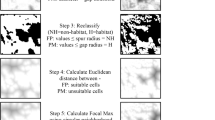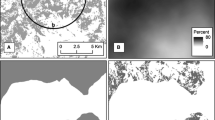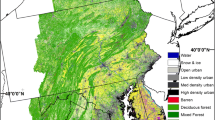Abstract
Context
When predicting locations of invasive plant species, map** habitat fragmentation can be an important part of the prediction process. There are many different fragmentation map** programs, each computing a unique set of fragmentation metrics that can be used in modeling probabilities of invasive species presence.
Objectives
In this study, we compare the results from five freely available fragmentation programs: FRAGSTATS; the Landscape Fragmentation Tool; Shape Metrics; Patch Analyst; and PolyFrag. We compare these programs quantitatively on their ability to predict invasive plant presence and qualitatively for ease of use.
Methods
The programs were compared using invasive plant inventories completed by The Nature Conservancy on parcels within the Coastal Watershed in New Hampshire, USA. Known locations of invasive plants, pseudo-absence locations, and metrics derived from each of the fragmentation programs were used to create maps of predicted presence for the parcels. The maps were compared and assessed for accuracy.
Results
FRAGSTATS and PolyFrag created prediction maps with the highest accuracies and were relatively easy to use. The other programs had lower accuracies or were more difficult to implement. Both FRAGSTATS and PolyFrag compute similar fragmentation metrics and the models found similar metrics significant in predicting presence. Both programs predicted that invasive plants were less likely to be found in deciduous forests than in either mixed or coniferous forests.
Conclusions
At the parcel level, some fragmentation programs result in metrics with more predictive power. Based on this analysis, we recommend FRAGSTATS for use with raster datasets and PolyFrag for vector datasets.



Similar content being viewed by others
References
Akaike H (1974) A new look at the statistical model identification. IEEE Trans Autom Control 19:716–722
Allen JM, Leininger TJ, Hurd JD Jr, Civco DL, Gelfand AE, Silander JA Jr (2013) Socioeconomics drive invasive plant richness in New England, USA through forest fragmentation. Landscape Ecol 28(9):1671–1686
Anderson RP, Lew D, Peterson AT (2003) Evaluating predictive models of species’ distributions: criteria for selecting optimal models. Ecol Model 162:211–232
Barbet-Massin M, Jiguet F, Albert CH, Thuiller W (2012) Selecting pseudo-absence for species distribution models: how, where, and how many? Methods Ecol Evol 3(2):327–338
Brothers TS, S**arn A (1992) Forest fragmentation and alien plant invasion of central Indiana old-growth forests. Con Bio 6(1):91–100
Brotons L, Thuiller W, Araújo MB, Hirzel AH (2004) Presence-absence verses presence-only methods for predicting bird habitat suitability. Ecography 27:437–448
Brown CD, Boutin C (2009) Linking past land use, recent disturbance, and dispersal mechanism to forest composition. Biol Conserv 142:1647–1656
Burnham KP, Anderson DR (2004) Model selection and multimodel inference: a practical information-theoretic approach, 2nd edn. Springer-Verlag New York Inc, New York, p 488
Cadenasso ML, Traynor MM, Pickett STA (1997) Functional location of forest edges: gradients of multiple physical factors. Can J of Forest Res 27:774–782
CLEAR (Center for Land Use Education and Research) (2009) Connecticut’s changing landscape, University of Connecticut. http://clear.uconn.edu/. Accessed June 2014
Congalton RG (1991) A review of assessing the accuracy of classifications of remotely sensed data. Rem Sens of Environ 37:35–46
Congalton RG (1997) Exploring and evaluating the consequences of vector-to-raster and raster-to-vector conversion. Photogramm Eng Rem S 60(4):434–435
Congalton RG, Green K (2009) Assessing the accuracy of remotely sensed data: principles and practices, 2nd edn. CRC Press, Boca Raton, p 208
Congalton RG, Oderwald RG, Mead RA (1983) Assessing Landsat classification accuracy using discrete multivariate statistical techniques. Photogramm Eng Rem S 49(12):1671–1678
DeGasperis BG, Motzkin G (2007) Windows of opportunity: historical and ecological controls on Berberisthunbergii invasions. Ecology 88(12):3115–3125
Elith J, Graham CH, Anderson RP, Dudik M, Ferrier S, Guisan A, Hijmans RJ, Huettmann F, Leathwick JR, Lehmann A, Li J, Lohmann LG, Loiselle BA, Manion G, Moritz C, Nakamura M, Nakazawa Y, Overton JMcC, Peterson AT, Phillips SJ, Richardson KS, Scachetti-Pereira R, Schapire RE, Soberon J, Williams S, Wisz MS, Zimmermann NE (2006) Novel methods improve prediction of species’ distributions from occurrence data. Ecography 29:129–151
Fahrig L (2003) Effects of habitat fragmentation on biodiversity. Annu Rev Ecol Evol S34:487–515
Fischer J, Lindenmayer DB (2007) Landscape modification and habitat fragmentation: a synthesis. Global Ecol Biogeogr 16:265–280
Foody GM (2002) Status of land cover classification accuracy assessment. Remote Sens Environ 80:185–201
Foster DR (1992) Land-use history (1730–1990) and vegetation dynamics in central New England, USA. J Ecol 80:753–772
Glode JS (2012) The Nature Conservancy, New Hampshire Chapter, Great Bay invasive species data. Unpublished raw data
Glode JS, Brickner-Wook J, Robinson E, Weisiger W, Wellenberger P, Stevens R (2012) Crommet Creek Conservation Area Management Plan. Report from The Great Bay Resource Protection Partnership. http://greatbaypartnership.org/Crommet%20Creek%20Conservation%20Area%20Management%20Plan%202012.pdf. Accessed Nov 2014
Gurevitch J, Fox GA, Wardle GM, Inderjit Taub D (2011) Emergent insights from the synthesis of conceptual framework for biological invasions. Ecol Lett 14:407–418
Gustafson EJ (1998) Quantifying landscape spatial pattern: What is the state of the art? Ecosystems 1:143–156
Harper KA, MacDonald SE, Burton PJ, Chen J, Brosofske KD, Saunders SC, Euskirchen ES, Robers D, Jaiteh MS, Esseen PA (2005) Edge influence on forest structure and composition in fragmented landscapes. Conserv Biol 19(3):768–782
Henderson S, Dawson TP, Whittakar RJ (2006) Progress in invasive plants research. Prog Phys Geog 30(1):25–46
Ibáñez I, Silander JA Jr, Wilson AM, LaFleur N, Tanaka N, Tsuyama I (2009) Multivariate forecasts of potential distributions of invasive plant species. Ecol Appl 19(2):359–375
Johnson VS, Litvaitis JA, Lee TD, Frey SD (2006) The role of spatial and temporal scale in colonization and spread of invasive shrubs in early successional habitats. Forest Ecol Manag 228(1–3):124–134
MacLean MG, Congalton RG (2013a) PolyFrag: a vector-based program or computing landscape metrics. GISci Remote Sens 50(6):591–603
MacLean MG, Congalton RG (2013b) Applicability of multi-date land cover map** using Landsat 5TM imagery in the Northeastern US. Photogramm Eng Rem S 79(4):359–368
McGarigal K, Cushman SA (2002) Comparative evaluation of experimental approaches to the study of habitat fragmentation effects. Ecol Appl 12(2):335–345
McGarigal K, Marks BJ (1995) FRAGSTATS: spatial pattern analysis program for quantifying landscape structure. USDA For Serv Gen Tech Rep PNW-351.http://www.umass.edu/landeco/research/fragstats/fragstats.html. Accessed June 2014
McGarigal K, Cushman SA, Ene E (2012) FRAGSTATS v4: Spatial Pattern Analysis Program for Categorical and Continuous Maps. Computer software program produced by the authors at the University of Massachusetts, Amherst.http://www.umass.edu/landeco/research/fragstats/fragstats.html. Accessed June 2014
Moran MA (1984) Influence of adjacent land use on understory vegetation of New York forests. Urban Ecol 8:305–323
Mosher ES, Jr SilanderJA, Latimer AM (2009) The role of land-use history in major invasions by woody plant species in the northeastern North American landscape. Biol Invasions 11:2317–2328
Parent J, Civco D, Hurd J (2007) Simulating future forest fragmentation in a Connecticut region undergoing suburbanization. Presented at ASPRS 2007 annual conference, p 11. Tampa, FL
Peterson AT (2003) Predicting the geography of species’ invasions via ecological niche modeling. Q Rev Bio 78(4):419–433
Rempel RS, Kaukinen D, Carr AP (2012) Patch analyst and patch grid. Ontario Ministry of Natural Resources, Centre for Northern Forest Ecosystem Research, Thunder Bay
Riitters KH, Wickham JD, O’Neill RV, Jones KB, Smith ER, Coulston JW, Wade TG, Smith JH (2002) Fragmentation of Continental United States Forests. Ecosystems 5:815–822
Turner MG (2005) Landscape ecology: What is the state of the science? Annu Rev Ecol Evol S 36:319–344
VanDerWal J, Shoo LP, Graham C, Williams SE (2009) Selecting pseudo-absence data for presence-only distribution modeling: How far should you stray from what you know? Ecol Model 220(4):589–594
Vogt P, Riitters KH, Estreguil C, Kozak J, Wade TG, Wickham JD (2007) Map** spatial patterns with morphological image processing. Landscape Ecol 22:171–177
With KA (2002) The landscape ecology of invasive spread. Conserv Biol 16(5):1192–1203
Zaniewscki AE, Lehmann A, Overton JMC (2002) Predicting spatial distributions using presence-only data: a case study of native New Zealand ferns. Ecol Model 157:261–280
Acknowledgments
The authors would like to thank the anonymous reviewers for their helpful suggestions and insightful comments that greatly improved our manuscript. Partial funding was provided by the New Hampshire Agricultural Experiment Station. This is Scientific Contribution Number 2592. This work was also supported by the USDA National Institute of Food and Agriculture McIntire-Stennis Project 0225003, as well as in part by Grant/Cooperative Agreement Number 08HQGR0157 from the United States Geological Survey via a sub-award from AmericaView. The contents of this manuscript are solely the responsibility of the authors and do not necessarily represent the official views of the USGS.
Author information
Authors and Affiliations
Corresponding author
Rights and permissions
About this article
Cite this article
MacLean, M.G., Congalton, R.G. A comparison of landscape fragmentation analysis programs for identifying possible invasive plant species locations in forest edge. Landscape Ecol 30, 1241–1256 (2015). https://doi.org/10.1007/s10980-015-0175-7
Received:
Accepted:
Published:
Issue Date:
DOI: https://doi.org/10.1007/s10980-015-0175-7




